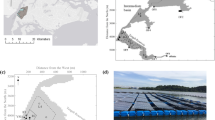Abstract
This paper describes a mathematical simulation model of the transformation of organic matter and biogenic compounds. The model is validated with observations made on Lake Ladoga. Despite the approximate nature of the biogenic load data, a good agreement is obtained between the calculated substance concentrations and available observations made during individual seasons for different areas of the lake. The model was developed by the author Leonov and this paper presents new model results with accurate formulations for nitrogen and carbon components. Comparison with observational data base collected during 1976–1979 shows that the model results provide good simulation of the annual seasonal changes in material concentrations in the identified regions of the lake.
Similar content being viewed by others
References
Filatov, N., 1991. Gidrodinamika ozer. Nauka, St. Petersburg, 196 pp. [Hydrodynamics of Lakes. In Russian].
Golterman, H., 1975. Physiological Limnology. Elsevier Scientific Publ. Co., Amsterdam, 489 pp.
Leonov, A., 1985. Modelling and explanation the phosphorus dynamics of Lake Balaton, 1976–79. IIASA Res. Rep., RR-85-3. Laxemburg. 59 pp.
Leonov, A., 1986. Matematicheskoe modelirovanie transformatsii soedinenii fosfora v presnovodnikh ekosistemakh (na primere oz. Balaton). Nauka, Moscow, 152 pp. [Mathematical modelling of phosphorus compound transformation in freshwater ecosystems. In Russian].
Leonov, A. & T. Aizatullin, 1975. Dinamika zakritoi BPK-sistemi opyt portretnogo matematicheskogo modelirovanija. Trudi GOIN 5: 5–46. [Dynamics of closed BOD systems. In Russian].
Leonov A. & T. Aizatullin, 1978. Modelirovanie transformatsii organicheskikh i neorganicheskikh veschestv soobschestvom mikroorganizmov v morskoi vode. Trudi GOIN 128: 105–137. [Modelling transformation of organic and inorganic matter by microorganism associations in seawater. In Russian].
Leonov, A., M. Ostashenco & E. Lapteva, 1991. Matematicheskoe modelirovanie protsessov transformatsii organicheskogo veschestva i soedinenii biogennykh elementov v vodnoi srede: predvaritelnyi analis uslovii funktsionirovaniya ekosistemy Ladozhskogo ozera. Vodniye resursy 1: 51–72. [Mathematical modelling of processes by which organic matter and compounds of biogenic elements are transformed in aquatic environments. In Russian].
Wang L. & M. Wang, 1976. Computer-aided modelling of stream purification capacity. 1. Non-linear DO models. Proc. Inst. Environ. Technol. 76: 553–557.
Author information
Authors and Affiliations
Rights and permissions
About this article
Cite this article
Leonov, A.V., Filatov, N.N. & Titov, V.S. The estimation of current state of Lake Ladoga using mathematical models. Hydrobiologia 322, 103–108 (1996). https://doi.org/10.1007/BF00031813
Issue Date:
DOI: https://doi.org/10.1007/BF00031813




